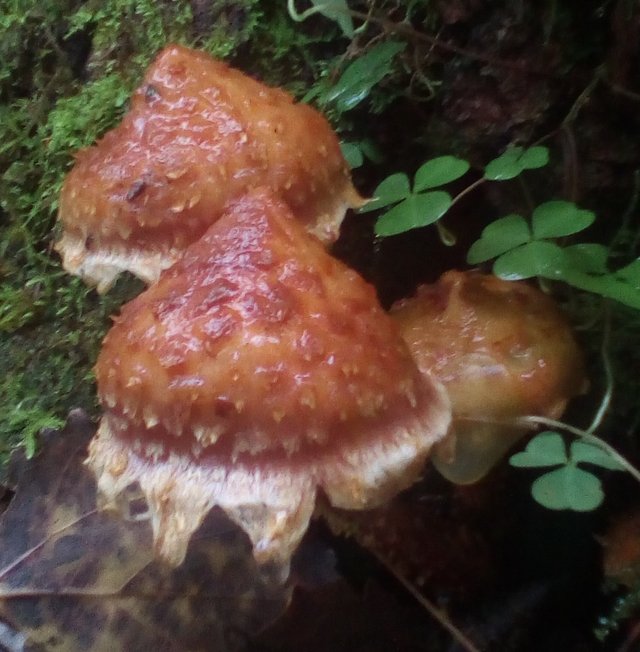White flake (Hemistropharia albocrenulata)
- Division: Basidiomycota (Basidiomycetes)
- Subdivision: Agaricomycotina (Agaricomycetes)
- Class: Agaricomycetes (Agaricomycetes)
- Subclass: Agaricomycetidae (Agaricomycetes)
- Order: Agaricales (Agaric or Lamellar)
- Family: Strophariaceae (Strophariaceae)
- Genus: Hemistropharia (Hemistropharia)
- Type: Hemistropharia albocrenulata (White flake)
:
- Pholiota albocrenulata
- Hebeloma albocrenulatum
- Stropharia albocrenulata
- Pholiota fusca
- Agaricus albocrenulatus
- Hemipholiota albocrenulata

Hemistropharia is a genus of agaric fungi, with the classification of which there are still some ambiguities. Possibly the genus is related to Hymenogastraceae or Tubarieae. Monotypic genus, contains one species: Hemistropharia albocrenulata, the name is Scaly white.
This species, originally named Agaricus albocrenulatus by the American mycologist Charles Horton Peck in 1873, has been renamed several times. Among other names, Pholiota albocrenulata and Stropharia albocrenulata are common. The genus Hemistropharia strongly resembles the typical Pholiota (Foliota), it is in this genus that the flake beetlegrass was originally classified and described, and it is considered a wood-destroying fungus, like the real Foliot.
Microscopic differences: Unlike Pholiota, Hemistropharia has no cystidia and darker basidiospores.
head: 5-8, under good conditions up to 10-12 centimeters in diameter. In young mushrooms, it is bell-shaped, hemispherical, with growth it takes the form of a plano-convex, it can be broadly bell-shaped, with a pronounced tubercle.
The surface of the cap is covered with concentrically arranged wide, light (slightly yellowish) lagging fibrous scales. In adult specimens, scales may be absent.
On the lower edge of the cap, white felt hanging scales are clearly visible, forming an elegant rim.
The color of the hat varies, the color range is red-brown to dark brown, chestnut, chestnut-brown.
The skin of the cap in wet weather is slimy, easily removed.
plates: adherent, frequent, in young mushrooms very light, light gray-violet. Most sources indicate this detail – the plates with a faint purple tint – as a distinctive feature of the white flake. Also, young mushrooms often have white, light, oily drops on the edges of the plates. In older mushrooms, it is noted that dark purple-brown clusters can be seen inside these drops.
With age, the plates acquire chestnut, brown, greenish-brown, violet-brown colors, the edges of the plates may be jagged.
Leg: 5-9 centimeters high and about 1 cm thick. Dense, solid, with age – hollow. With a fairly well-defined white ring in young mushrooms, turned up like a bell; with age, the ring acquires a somewhat “tattered” appearance, may disappear.
Above the ring, the leg is light, smooth, longitudinally fibrous, longitudinally striated.
Below the ring it is densely covered with large, light, fibrous, strongly protruding scales. The color of the stem between the scales is yellowish, rusty, brown, to dark brown.
Pulp: light, whitish, yellowish, yellower with age. Dense.
Smell: no special smell, some sources note sweetish or slightly mushroomy. Obviously, much depends on the age of the fungus and growing conditions.
Taste: bitter.
spore powder: brown-violet. Spores 10-14 x 5.5-7 µm, almond-shaped, with a pointed end. Cheilocystidia are bottle-shaped.
It parasitizes on living hardwood, most often on aspen. It can grow in tree cavities and on roots. It also grows on rotten wood, also mainly aspen. It occurs infrequently, in small groups, in the summer-autumn period.
In Our Country it is noted in the European part, in Eastern Siberia and the Far East. Outside of Our Country, it is distributed in Europe, North Africa and North America.
Inedible due to bitter taste.
In dry weather, it can look like a destructive flake.
: Pholiota albocrenulata var. albocrenulata and Pholiota albocrenulata var. conica. Unfortunately, no clear descriptions of these varieties have yet been found.
Photo: Leonid









